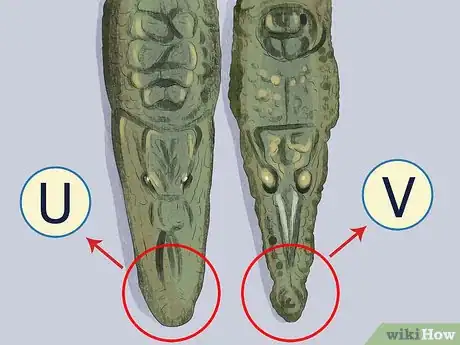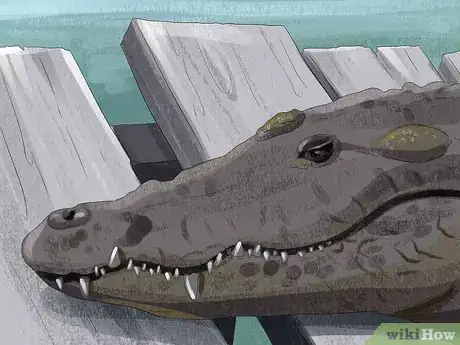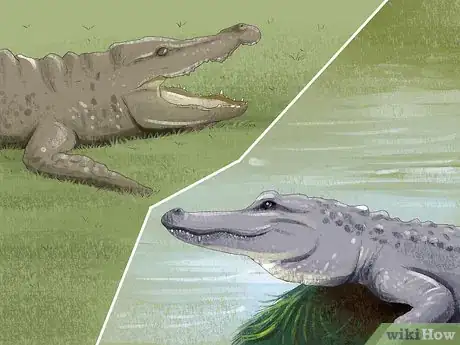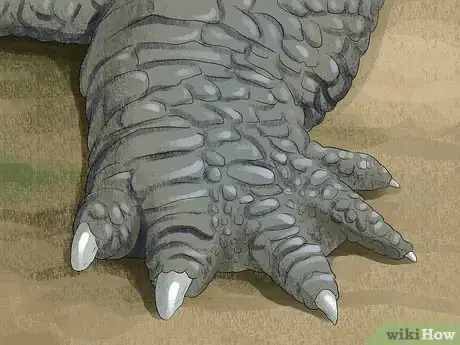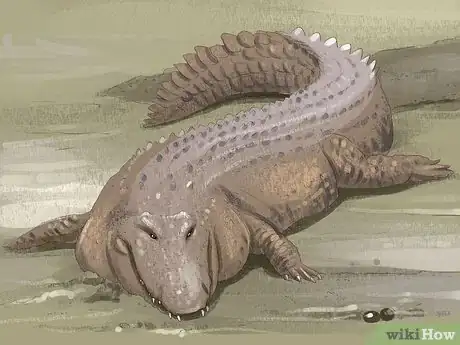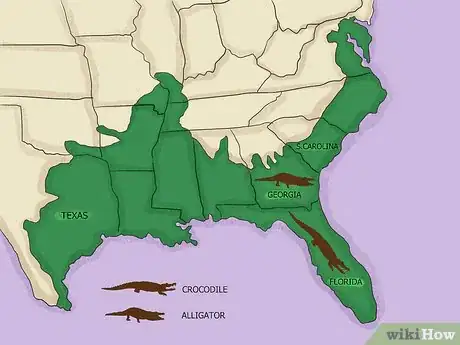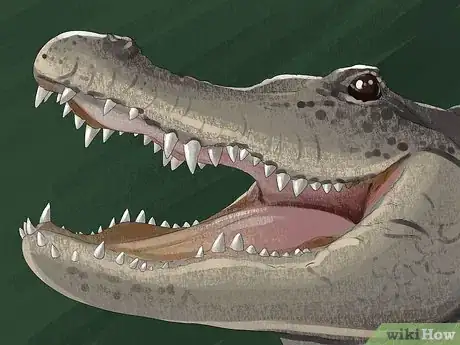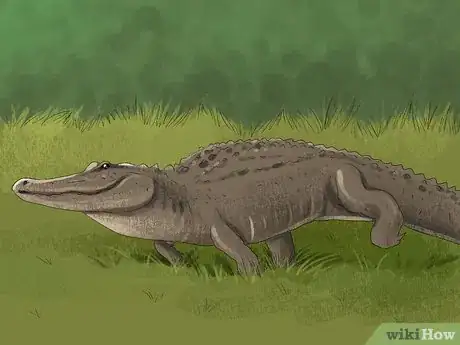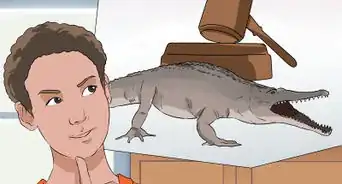This article was co-authored by wikiHow Staff. Our trained team of editors and researchers validate articles for accuracy and comprehensiveness. wikiHow's Content Management Team carefully monitors the work from our editorial staff to ensure that each article is backed by trusted research and meets our high quality standards.
There are 7 references cited in this article, which can be found at the bottom of the page.
wikiHow marks an article as reader-approved once it receives enough positive feedback. This article received 12 testimonials and 84% of readers who voted found it helpful, earning it our reader-approved status.
This article has been viewed 510,339 times.
Learn more...
Alligators and crocodiles are commonly confused with one another, and the words are often used interchangeably. Although they look similar, there are a few key physical characteristics that can help you easily distinguish between crocodiles and alligators.
Steps
Observing Their Physical Differences
-
1Look at the snout. The easiest way to tell the difference between crocodiles and alligators is to look at their snouts. Alligators have a wide, rounded, "U"-shaped snouts with larger noses, whereas crocodiles have longer, thinner, pointed "V"-shaped snouts and smaller noses. Alligator snouts are also shorter than crocodile snouts.
- The broad snouts that alligators have give them more strength than crocodiles. They can crush hard shelled prey, such as turtles, much easier than crocodiles can.[1] Crocodiles tend to eat more fish and mammals.
-
2Pay attention to the teeth. The crocodile's upper and lower jaws are nearly the same width, so the teeth are exposed all along the jaw line in an interlocking pattern, even when the mouth is closed. An alligator, on the other hand, has a wider upper jaw, so when its mouth is closed the teeth in the lower jaw fit into sockets of the upper jaw, hidden from view. Only the teeth of the upper jaw are exposed along the lower jaw line.
- Alligators' upper jaws are wider than their lower jaws, so the upper jaw overlaps the lower jaw. Because of this, the teeth in the lower jaw are hidden when their mouth closes.
- Crocodiles' upper and lower jaws are approximately the same width, so their upper and lower teeth interlock when their mouth shuts. This causes some of their teeth to show when their mouth closes. They'll almost look like they're smiling, as the fourth tooth on each side of the lower jaw sticks up over the upper lip.[2]
Advertisement -
3Observe their bodies. Alligators tend to have a darker skin than crocodiles do. Crocodiles normally have lighter skin, usually in the colours of olive green or brown. Alligators usually have darker, blackish-grey skin. Crocodiles are also longer than alligators. On average, full grown crocodiles are 5.8 meters, whereas full grown alligators are 3.4 meters.[3]
-
4Look at the difference in their legs and feet. Most crocodiles have a fringe type appearance on their hind legs and feet that alligators do not. Also, alligators have webbed feet, and crocodiles do not.[6]
Considering Their Natural Habitat
-
1Determine if the animal is in fresh water. Due to their low tolerance for salt, alligators typically live in fresh water habitats. Alligators will sometimes live in brackish water (salt water and fresh water mixed together) as well. Alligators primarily inhabit swamps and marshes, but can also be found in rivers, lakes, and other small bodies of water. They generally prefer warmer temperatures, but can survive in freezing temperatures as well.[7]
-
2Determine if the animal is in a tropical climate or salt water. As opposed to alligators, crocodiles have modified salivary glands on their tongues to help them tolerate salt water. Crocodiles usually live near lakes, rivers, wetlands and some saltwater regions. They live in tropical climates because they are cold-blooded and can't generate their own heat.[8]
-
3See where the animal is in the world. Crocodiles are found in the tropical areas of Africa, Asia, Australia, and the Americas. Alligators live in the southern United States and China. The United States is the only country that both alligators and crocodiles inhabit.
- American alligators are most commonly found in Florida and Louisiana, and are less commonly found in Alabama, Georgia, South Carolina, Mississippi, and Texas.
- American crocodiles are usually found in Florida.[9]
Observing Their Personalities
-
1Observe how active they are in the water. Crocodiles tend to be much more active and spend much more time in the water than alligators. Alligators spend most of their time laying in mud or the greenery surrounding marshals and lakes.[10]
- Alligators tend to lay their eggs in mounds of vegetation surrounding freshwater.
- Crocodiles lay their eggs in slightly drier places like mud or sand.[11]
-
2See how aggressive they are. Crocodiles tend to be much more aggressive than alligators. Crocodiles are more likely to attack at random when something comes near, whereas alligators are more likely to wait until hungry or threatened to attack.
- In their natural habitat and in zoos, crocodiles have much more aggressive behavior towards humans than alligators.
-
3Observe their speed. Crocodiles and alligators are both extremely fast swimmers, both swimming up to 20 mph. On land, they are a bit slower, typically running up to 11mph. Since they are smaller and do not get tired as easily, alligators can typically run for longer periods of time than crocodiles.[12]
Community Q&A
-
QuestionCan crocodiles and alligators breed?
 ArtemiTop AnswererThey are related, but too distant genetically to have offspring.
ArtemiTop AnswererThey are related, but too distant genetically to have offspring. -
QuestionAre crocodiles and alligators reptiles?
 Animallover24Community AnswerYes, they are.
Animallover24Community AnswerYes, they are. -
QuestionIs the eye placement different between the two?
 KarinTop AnswererNo. The eye placement is very similar in both.
KarinTop AnswererNo. The eye placement is very similar in both.
Warnings
- Do not go near an alligator or crocodile unless you are with a professional handler as they can be very aggressive.⧼thumbs_response⧽
- If you are actually going to enter an alligator' or crocodile's habitat, be careful not to do so in a way that provokes aggression. Remember that males become even more aggressive during spring mating season.⧼thumbs_response⧽
References
- ↑ http://crocodilian.com/cnhc/cbd-faq-q1.htm
- ↑ http://www.livescience.com/32144-whats-the-difference-between-alligators-and-crocodiles.html
- ↑ http://www.diffen.com/difference/Alligator_vs_Crocodile
- ↑ http://animals.nationalgeographic.com/animals/reptiles/saltwater-crocodile/
- ↑ http://www.diffen.com/difference/Alligator_vs_Crocodile
- ↑ http://www.diffen.com/difference/Alligator_vs_Crocodile
- ↑ http://www.livescience.com/32144-whats-the-difference-between-alligators-and-crocodiles.html
- ↑ http://www.livescience.com/28306-crocodiles.html
- ↑ http://tracker.cci.fsu.edu/alligator/about/where/
- ↑ https://books.google.com/books?id=nWwbAAAAMAAJ&pg=PA287&lpg=PA287&dq=Crocodiles+are+more+active+than+alligators&source=bl&ots=NgGVTjAQ9J&sig=_VbevR1_1YJgkdigf1d7IXSjD7A&hl=en&sa=X&ved=0ahUKEwiC05z_pMbLAhUonoMKHcFuB0QQ6AEIeTAS#v=onepage&q=Crocodiles%20are%20more%20active%20than%20alligators&f=false
- ↑ http://www.diffen.com/difference/Alligator_vs_Crocodile
- ↑ http://www.livescience.com/28306-crocodiles.html
About This Article
The best way to tell the difference between a crocodile and an alligator is to look at the snout. If the snout is “V” shaped with a thin, pointed nose, it’s a crocodile! If the animal has a shorter, wider, “U” shaped snout, it’s an alligator! You can also figure out which animal it is based on where you are: it’s an alligator if you’re in the Southern US or in China. However, if you’re in Florida or other tropical zones like Africa, Asia, and Australia, it’s a crocodile.
